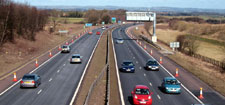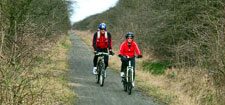Transport
In recent decades social and economic changes have led to mass car ownership, increases in road freight and changing patterns of travel for work, business and leisure. This has lead to both higher levels of traffic and the development of new infrastructure to cope with demand. There is growing recognition of the detrimental effects of transport on the environment, the economy and quality of life. This requires a new approach to ensure that future needs are provided for in away that reduces the impact of transport on people and their environment.
Increased traffic levels and new transport infrastructure can bring changes to the landscape in a number of ways.
- Road verges and roadside vegetation can be affected by pollution, salt spray and physical damage.
- Roadside walls and buildings may be affected by physical damage or vibration.
- Minor road works can erode the distinctive character and rural quality of minor roads.
- The use and enjoyment of country roads by walkers, cyclists and horse riders may be impaired.
- The rural character of the landscape may be affected by the introduction of new development – new landforms, bridges, surfaces, lighting, signage, landscaping and moving traffic.
- The tranquillity of the countryside may be weakened by noise and light pollution.
- Landscape features like natural landforms, hedgerows and mature trees may be lost.
- The structure of the landscape and the connectivity of habitats may be disrupted.
Transport Planning
The Local Transport Plan 2006-2011 (LTP) outlines the approach towards the development of all forms of transport in the county and a programme of capital works for the plan period. In towns and villages it places an emphasis on the development of places for people to walk and cycle safely, and the improvement of public transport. In the countryside the main focus for action is sustaining the accessibility of jobs and services for the many people living in the countryside without access to a car and alleviating the impacts of private car use. The plan recognises the need to limit future traffic growth and the need to look for other solutions before new road construction is considered. Improvements to the highway network are proposed in some locations, including the provision of bypasses to remove traffic from towns.
Issues and Objectives
New Transport Infrastructure
The impacts of new infrastructure on the character of the landscape can be substantial. These can be reduced in some degree by careful route selection and engineering design, by retaining or translocating mature landscape features, by minimising lighting, by selecting materials and plant species for landscaping works which reflect the character of the local landscape, and by on and off-site planting. Most new development requires planning consent and in many cases the preparation of an Environmental Statement. The Landscape Assessment provides baseline information on landscape character which can inform these processes.
Objectives
- To ensure that new transport infrastructure is designed to minimise its impact on the character of the local landscape.
Minor Road Works
The character of minor rural roads and lanes, from sunken hollow-ways and narrow winding lanes in the lowlands to straight enclosure roads in the upland fringes, is often an important component of local distinctiveness. Minor engineering improvements like junction improvements, traffic calming, road widening, and the easing of bends, kerbing, lighting and signage, can weaken their character as well as having a generally urbanising effect on the rural landscape. This can often be minimised by careful planning and design. The recent Guidelines for the Management of Roads in the North Pennines AONB provides a useful model for developing character area based guidelines elsewhere in the county.
Objectives
- To ensure that highway improvement works respect the rural and historic character of minor roads and lanes.
- To support the preparation of area based guidelines for the management of roads.
Traffic Management
High levels of traffic on rural roads affect both their physical fabric and their use and enjoyment by other groups – cyclists, horse riders and walkers. In some places this can be addressed by traffic management measures. Road networks can be designated as ‘Quiet Lanes’ or as access only routes where motorised traffic is discouraged. Weight restrictions and signage can reduce through traffic. The removal of road markings can reduce the speed of traffic. Under the Transport Act 2000 local authorities were given powers to designate Quiet Lanes and their development is being promoted through the Natural England’s Quiet Lanes initiative. The Local Transport Plan provides for the identification of quiet routes and traffic calming measures in the countryside.
Objectives
- To support measures which reduce or manage traffic on rural roads.
- To support and promote the development of Quiet Lanes.
Cycling, Walking and Horse Riding
Cycling, walking and horse riding, whether for utility or recreation, can reduce motorised traffic and its impacts on the environment. The county is well provided with cycle ways and bridleways, many on old railway lines, but connections between many towns and villages remain on busy roads. The Local Transport Plan contains policies on the creation of cycle routes, including inter-urban utility and recreational routes. The County Durham Cycling Strategy and County Durham Walking Strategy promote cycling and walking and inform the Local Transport Plan. The Safer Routes to School project seeks to develop safe routes for schoolchildren. Natural England is promoting the development of ‘Greenways’ – multi-user car-free networks- providing people with the option of making journeys for work or leisure on foot, cycle or horseback.
Objectives
- To support and encourage initiatives which promote cycling and walking.
- To support the creation of Greenways between towns and villages.
Road Verges
Road verges are an attractive part of the highway landscape and an important habitat for wildlife. They often contain remnants of species rich grasslands that are declining in the wider countryside. These verges need to be managed to maintain their attractiveness and species diversity. Existing records of important roadside verges are held on a GIS database by the County Council, including records from recent surveys in the North Pennines by the Durham BAP partnership. Further work is needed to complete this process to ensure the protection and conservation of important verges across the county. Roadside hedges, trees, woodlands and scrub also make an important contribution to the character and scenic quality of the landscape. They are vulnerable to physical damage, minor road improvements and routine maintenance works.
Objectives
- To support further surveys of roadside vegetation.
- To encourage the conservation and appropriate management of roadside verges



